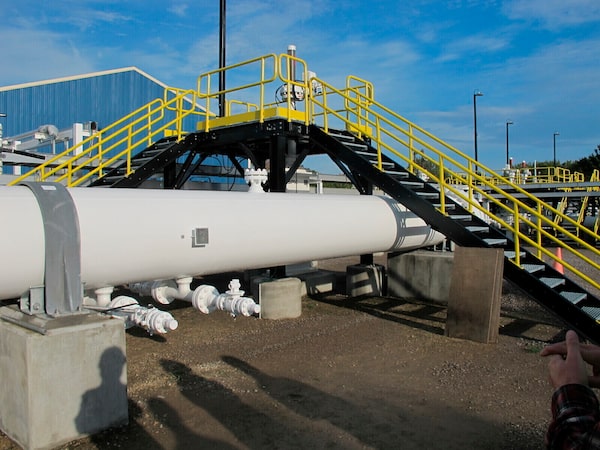
An aboveground section of Enbridge's Line 5 at the Mackinaw City, Mich., pump station.John Flesher/The Associated Press
A Canadian environmentalist group is challenging the idea that a shutdown of Enbridge’s Line 5 pipeline would trigger an energy crisis and has commissioned an economic report that says viable alternatives exist to deliver the same petroleum supplies to Central Canada.
Calgary-based Enbridge Inc.’s 1,038-kilometre pipeline is a crucial petroleum conduit for Ontario and Quebec that carries up to 540,000 barrels per day of Alberta and Saskatchewan petroleum through Great Lakes states before re-entering Canada at Sarnia, Ont. Its future is uncertain after Michigan Governor Gretchen Whitmer ordered the pipeline shut down over fears of an oil spill where it crosses the Straits of Mackinac waterway in her state. It remains in operation but Canada and the United States are in negotiations over the matter after Ottawa invoked a 1977 bilateral treaty.
Toronto-based Environmental Defence, relying on new analysis from a U.S. energy industry expert, says Line 5 can be halted with little impact on Canadian consumers or the price of gasoline. “With an orderly shutdown of Line 5, the projected cost of alternatives essentially goes unfelt by consumers,” the group says. It estimates gasoline prices would only increase by 1.8 cents as a result.
The report being released Wednesday says another Enbridge pipeline, Line 78, could be relied upon to handle much of the crude oil shortfall. Line 78, like Line 5, also connects to Sarnia, and Environmental Defence says this pipeline is not being used to its full capacity. It recommends increasing shipments through Line 78 and adds that upgrading pumping facilities could enable this pipeline to ship even more.
“If Line 78 was upgraded to the capacity it was designed for, it could make up the majority of any shortfall caused by a Line 5 closure,” Environmental Defence says in a statement accompanying the report.
Economic analysis for the report is provided by Martin Meyers of New Hampshire-based Meyers Energy Consulting. Mr. Meyers’s work history includes Shell, Irving Oil and Cambridge Energy Research Associates.
The remainder of the crude oil shortfall could be handled by shipping via rail or marine tankers or a combination of both, Environmental Defence said. Mr. Meyers’s report says investment in additional rail-car off-loading facilities at refineries in Ontario and Quebec could increase deliveries of crude oil by rail.
Line 5 also carries upwards of 80,000 barrels per day of natural gas liquids to Sarnia, where they are refined into products such as propane. Mr. Meyers’s report says there has been a significant rise in natural gas liquids production from shale resources in the U.S. Midwest and Northeast and these locations could provide an alternative source of supply for Canada.
Mr. Meyers added, however, that his analysis assumes a planned shutdown of Line 5 with sufficient time to make required infrastructure investments and obtain permits. He couldn’t say precisely how much time would be required to upgrade Line 78 and the rail-car unloading facilities.
“I think it’s fair to say that these are generally speaking not super-long lead-time type of investments. They are not many, many years. But it’s also not a couple of months,” he said. However, he added that these are relatively less complex investments in oil infrastructure. “It’s relatively simple stuff that needs to be done.”
Former federal natural resources minister Seamus O’Regan last year declared that a shutdown of Line 5 would threaten Canada’s energy security and its continued operation is “non-negotiable.”
Enbridge has said there are currently no alternatives to deliver the energy that Line 5 transports.
In comments to The Globe and Mail earlier this year, Enbridge spokesman Jesse Semko said the company’s mainline pipeline system “is at capacity” and no pipelines other than Line 1 and Line 5 are able to transport natural gas liquids. Line 1 ends at Superior, Wis., far from Sarnia. Line 78, which is broken into two parts, 78A and 78B, is “substantially full,” Mr. Semko said, and also cannot transport natural gas liquids.
Enbridge has said replacing Line 5 with alternatives such as rail cars is “not in the best interest of the environment or safety of the public.” In 2013, for instance, a train carrying crude oil jumped the tracks in Lac-Mégantic, Que., causing a series of explosions that killed 47 people and flattened dozens of buildings.
Enbridge’s Mr. Semko said it would take years to develop alternatives to transporting petroleum by pipeline.
Enbridge is still awaiting regulatory approval for a workaround that it says would further insulate the Great Lakes from a potential spill. Right now, Line 5 splits into two pipelines that enter the Straits of Mackinac and run along the seabed from Michigan’s Upper Peninsula to the Lower Peninsula where they reunite into one line.
The company is proposing to build a US$500-million tunnel that would run deep under the Straits of Mackinac – as much as 100 feet below – as an alternative to the current route. It would bore through the rock under the waterway in what company advertising says would “virtually eliminate the chance of a pipeline incident in the Straits.”
“Based on the energy needs of Michigan, other Great Lakes states and Canada’s two largest provinces, it makes no sense to shut Line 5 down,” Mr. Semko said. “The best long-term opportunity to secure the energy needs of these regions is the Great Lakes Tunnel Project, which we’re continuing to advance.”
Michelle Woodhouse, program manager for fresh water and the Great Lakes at Environmental Defence, said the planned shutdown and replacement infrastructure her group is proposing would take far less time to put into effect than the tunnel project Enbridge is pursuing. And a tunnel would not mitigate the risk of spills elsewhere on the Line 5 route, she said.
Know what is happening in the halls of power with the day’s top political headlines and commentary as selected by Globe editors (subscribers only). Sign up today.